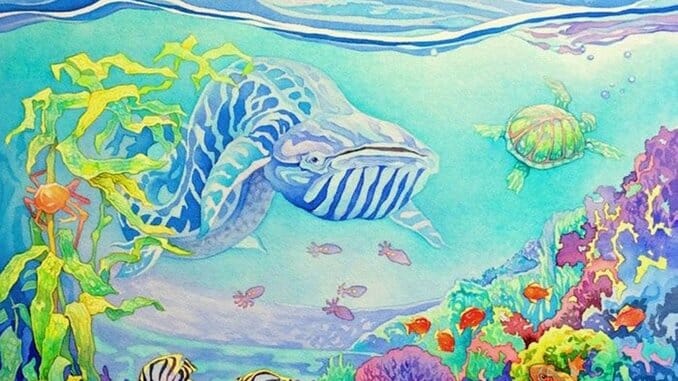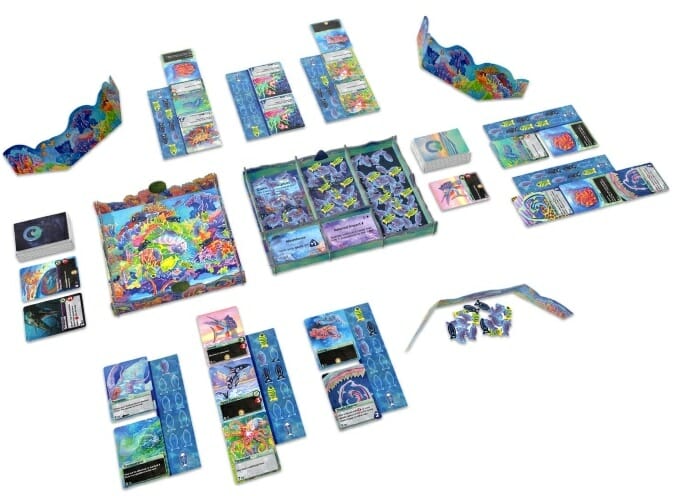
Oceans is a new, standalone sequel game to 2014’s Evolution, which itself has spawned several expansions and an outstanding digital adaptation released last year. Both games borrow concepts from natural selection by having players form species and play traits on them to make them stronger predators, improve their defensive abilities, or otherwise help them survive the game’s process of not-quite-natural selection, but Oceans smooths out some of the gameplay issues in Evolution for a better playing experience.
As the name might have told you, Oceans is set in the seas, as players will build aquatic species and will draw food from four different layers of the ocean—at least until they start attacking each other, which is a core part of the game and works better here than it did in Evolution. As in the preceding game, Oceans revolves around Trait cards, which you can play to the table to create a new species or play to modify a species you’ve already created. You can have up to three Trait cards on each species, and may discard a played Trait at any time to play a new one to that species. You can also discard a Trait card to move food tokens between the zones available to all players, which can be a self-serving move or a strategic move to mess with your opponents’ species.
The goal in Oceans is to end the game with the most (consumed) food tokens, as you’ll take one off of each of your species cards during each round and sometimes will get to use Trait cards to take more. Thus feeding your species is the heart of the game. The Trait cards on a species will determine if it can Forage for food by taking it from the highest zone that still has food in it, or if it can attack other species for food, or can do either. Many Trait cards also forbid that species from doing one or the other, forcing you to make that species a forager or a predator.
On each turn, you play one or two trait cards, then feed one of your species by foraging or attacking. Once that’s complete, you’ll remove one food token from every one of your species to score it at game-end and then draw cards to get your hand back up to six. Turns are thus quite simple and should move quickly once everyone is familiar with the game’s mechanics, although the Trait cards you’ll draw from the special Deep deck are all unique and players may spend a few moments considering how those cards will play out on the table.

Oceans dispenses with the original Evolution game’s dichotomy of giving species both population size and body size characteristics, instead just giving every species a population board that has ten spaces on it. You can fill nine of them without penalty via feeding or other card bonuses, but if you fill the tenth, you trigger “overpopulation” and must return half of the food tokens to the ocean. The result is that your calculus is simpler—you’re no longer scanning prey for body sizes and mentally modifying them based on trait cards—but you now have to think about whether any of your species might overpopulate if you don’t try to remove more food or traits from them.
The game unfolds in stages, with players playing one card per turn until the first Ocean Zone is emptied of food for the first time, which triggers the Cambrian Explosion and allows players to play two cards per turn. This also allows players to score (remove) two food tokens from species cards per turn, and allows players to play Deep trait cards that are more powerful but cost food tokens you’ve already scored. (Regular trait cards are free to play.) Those Deep cards are unique, and most of them amp up features already found in the game, such as letting players score additional food tokens in each round, making species impervious to attacks, or allowing species to have a fourth trait card. This is also where the designers had a bit of fun, with trait cards called the Kraken, Behemoth, and Cthlulu Leech, all with appropriately terrifying artwork to match.
Oceans draws its general mechanics from natural selection, but its educational component is less transparent; if you play with the Deep cards, there are many actual traits or references to real species that could send a player to the internet to learn more about symbiosis, zooplankton, telomeres, or bioluminescence. And there’s an underlying concept of food scarcity and how limited resources drive species to evolve or die off, just as there was in the original game.
Prior to its release, Oceans was designed as a 2-6 player game, but the base game now plays just 2 to 4 as the designers realized the 5+ player game was going to be way too long. (I demoed it at PAX Unplugged in 2018 with five players, and yeah, it was quite long.) The ideal player count here is 3 or 4, because so many trait cards depend on what adjacent species are doing, and with more than two players you get a broader mix of species and less of the tit-for-tat setup you’ll likely have with two—although the game still works with two players, just playing out differently. It’s a faster experience than the original Evolution, and the way food tokens move between zones avoids the first game’s desperation phase when there are more species trying to feed than there are tokens available. Oceans also features more ornate, colorful art from Catherine Hamilton, the artist behind the original game, along with some designs on Deep cards from other artists, making this one of the most visually appealing games of the last year. If you liked the original Evolution, I think you’ll prefer Oceans for the way it streamlines gameplay and balances out the foraging/carnivore mechanic, and keeps player turns shorter for a more enjoyable experience no matter the player count.
Keith Law is the author of Smart Baseball and a senior baseball writer for The Athletic. His latest book, The Inside Game, is due out in April 2020. You can find his personal blog the dish, covering games, literature, and more, at meadowparty.com/blog.